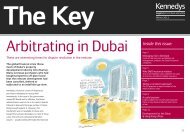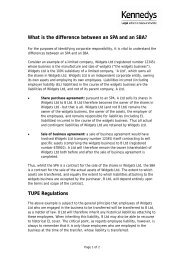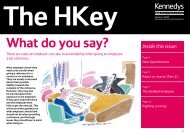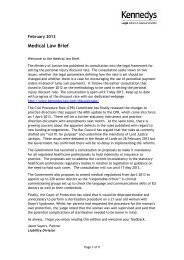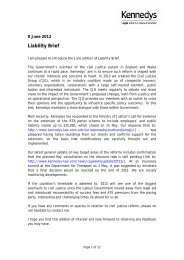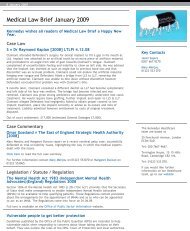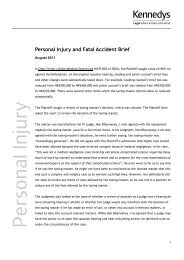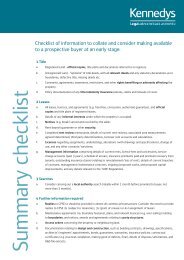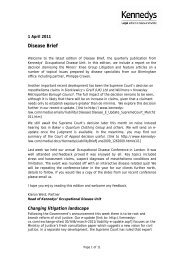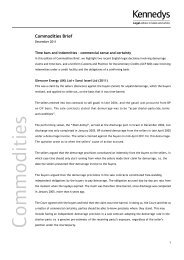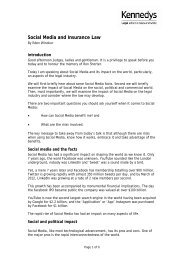Download The Key - Summer 2008 (PDF, 359KB). - Kennedys
Download The Key - Summer 2008 (PDF, 359KB). - Kennedys
Download The Key - Summer 2008 (PDF, 359KB). - Kennedys
Create successful ePaper yourself
Turn your PDF publications into a flip-book with our unique Google optimized e-Paper software.
<strong>The</strong> <strong>Key</strong><br />
June <strong>2008</strong><br />
Fat or fiction?<br />
<strong>The</strong> risk of obesity claims against the UK food industry is growing.<br />
Today, on a global scale, more than<br />
a billion adults are overweight.<br />
Constantly bombarded with reality<br />
TV shows such us<br />
“Supersize me v<br />
Superskinny me” and “<strong>The</strong><br />
Biggest Loser”, we live in a<br />
society increasingly<br />
obsessed with losing<br />
weight. This obsession has<br />
seen a steady rise in product<br />
liability actions based on<br />
food consumption being<br />
brought against the food<br />
industry, particularly in the<br />
US. This article gives food<br />
providers and their insurers a<br />
taste of the main ingredients of<br />
obesity claims.<br />
What are obesity claims?<br />
<strong>The</strong> underlying allegation in such claims<br />
is the negligent provision of fatty and<br />
unhealthy food that injures consumers of<br />
such food by causing obesity and obesity-related<br />
diseases such as Type 2 diabetes, hypertension<br />
and high cholesterol.<br />
Who is to blame?<br />
Food manufacturers, particularly fast food<br />
chains, are<br />
increasingly in the<br />
spotlight for their<br />
potential failure to<br />
take responsibility<br />
for providing healthy<br />
food to their<br />
consumers. <strong>The</strong>re is<br />
also the question of<br />
the onus on doctors<br />
to give patients<br />
advice about their<br />
dietary needs. And<br />
celebrity chef Jamie<br />
Oliver recently<br />
highlighted the<br />
responsibility of<br />
schools in<br />
providing healthy<br />
lunchtime options to<br />
children. However, as with the<br />
tobacco litigation, there is also the<br />
Inside this issue:<br />
Page 4<br />
Nailing the real culprits<br />
A French court has ordered a classification<br />
society and charterers to pay<br />
Page 5<br />
Direct offshore foreign insurers<br />
<strong>Key</strong> Australian regulatory exemptions have now<br />
been finalised<br />
Page 6<br />
Getting mediation to work<br />
A personal view<br />
Page 7<br />
Not a CAR crash<br />
Despite recent judicial events<br />
Page 9<br />
Victims of Success<br />
It is a popular urban myth that lawyers<br />
encourage disputes<br />
Page 10<br />
Resolving higher value cases<br />
A new pilot scheme is to be launched shortly<br />
1
ongoing debate about consumers’ personal<br />
responsibility, individual choice and common<br />
sense when it comes to regulating what and<br />
how much they eat.<br />
<strong>The</strong> Pelman case<br />
<strong>The</strong> most pivotal test case so far is Pelman v<br />
McDonald’s. This is the first obesity claim to<br />
be litigated against a fast food company and<br />
is yet to go to trial in the US. <strong>The</strong> claim was<br />
filed in 2002 by the parents of two New York<br />
teenagers who claimed to be “regular”<br />
McDonald’s customers. <strong>The</strong>y are seeking<br />
damages for their daughters’ obesity, which<br />
they allege was caused by<br />
McDonald’s negligence,<br />
deception and failure to warn.<br />
<strong>The</strong> lawsuit has been allowed to<br />
proceed on the basis of violation<br />
of the New York’s Consumer<br />
Protection Act. Its outcome is<br />
eagerly awaited, as it could prove<br />
a catalyst for similar claims across<br />
the globe.<br />
UK law and regulation<br />
Given that the first obesity claim is<br />
yet to be brought in the UK,<br />
there is an uncomfortable<br />
uncertainty about how<br />
claimants (and more<br />
importantly, the<br />
courts) would<br />
interpret relevant<br />
legislation, including<br />
the Food Safety Act<br />
1990, the Consumer<br />
Protection Act 1987<br />
(CPA) and the General<br />
Product Safety Regulations<br />
(GPSRs).<br />
Under the CPA, a person who is injured by a<br />
defective product can sue for compensation<br />
without having to prove the producer<br />
negligent, provided that they can<br />
demonstrate that the product was defective<br />
and that the defect caused the injury. <strong>The</strong><br />
CPA covers all consumer products (including<br />
food) and a claimant must begin court action<br />
within three years of the date they were<br />
injured. However, deciding exactly when an<br />
obese person has been injured by a fatty<br />
food and proving that the fatty food product<br />
is “defective” will doubtless generate<br />
extensive legal and academic debate.<br />
Under the GPSRs, a product must be “safe”.<br />
<strong>The</strong> GPSRs define a “safe product” as any<br />
product that, under normal or reasonably<br />
foreseeable conditions of use, presents no<br />
risk or only the minimum risk compatible with<br />
the product’s use. <strong>The</strong> extent to which a<br />
product is considered safe will be determined<br />
by having regard to a number of factors,<br />
including the characteristics and labelling of<br />
the product. Again, it may be difficult to<br />
argue that excessive consumption of a food<br />
product is “reasonable use”. However, if the<br />
food labelling is judged to be misleading in<br />
terms of its fat content, addictive nature or<br />
nutritional value, there may still be scope for<br />
criminal prosecution.<br />
German perspective<br />
At least the current German approach<br />
towards obesity claims is good news for food<br />
manufacturers. In the 2004 German case of<br />
Kieske v Haribo, the claimant was overweight<br />
and fell ill after eating a 400g bag of Haribo's<br />
assorted liquorices everyday for four months.<br />
Liquorice contains glycyrrhizic acid, which in<br />
high amounts can affect potassium levels.<br />
Once the claimant had recovered, she tried to<br />
sue Haribo under German product liability<br />
laws for its failure to warn her of the<br />
presence of glycyrrhizic acid in its liquorice<br />
and its effects. She also sued Haribo for<br />
selling king-sized packets, which she said<br />
induced overconsumption.<br />
Two years ago, Cadbury’s had<br />
to recall one million chocolate<br />
bars due to a low level<br />
contamination of salmonella.<br />
<strong>The</strong> regional court of Bonn dismissed Mrs<br />
Kieske’s claim and held her responsible for her<br />
illness because of her overconsumption.<br />
According to the court, the liquorice was not<br />
defective because it contained glycyrrhizic acid.<br />
German manufacturers are only required to list<br />
glycyrrhizic acid on food labels in Germany<br />
when its concentration in the liquorice is over<br />
0.2%. As Haribo's product has a smaller<br />
concentration, Haribo was not obliged to list the<br />
acid. <strong>The</strong> court further ruled that manufacturers<br />
need only warn of their product’s risks where<br />
they can reasonably expect the risk will arise<br />
from the “normal” use of the products – and<br />
400g of liquorice a day for four months was not<br />
2
“normal”. It also decided that Haribo’s decision<br />
to sell a king-sized packet was reasonable.<br />
Harmful ingredients<br />
<strong>The</strong> Haribo case also highlights the increasing<br />
potential of claims arising from products<br />
containing only a small quantity of potentially<br />
harmful products. Two years ago, Cadbury’s<br />
had to recall one million chocolate bars due<br />
to a low level contamination of salmonella. In<br />
the light of the recall, the Advisory<br />
Committee on the Microbiological Safety of<br />
Food (ACMSF) said that the presence of<br />
salmonella in ready-to-eat foods was<br />
“unacceptable” at any level. Professor Tom<br />
Humphrey of Bristol University Veterinary<br />
School commented that food such as<br />
chocolate, with a potentially large market of<br />
children, should have no salmonella present.<br />
This hint of a zero-tolerance approach<br />
reveals an interesting contrast with the<br />
acceptable low-level approach taken in the<br />
Haribo case. It further suggests that food<br />
manufacturers may come under scrutiny if<br />
they only cater for the average adult and do<br />
not consider the fact that people vary in<br />
susceptibility to certain levels of ingredients.<br />
Labelling<br />
Food labelling seems to be the key to<br />
reducing risk of liability for obesity claims.<br />
In 2006, Cadbury’s Schweppes and the<br />
Biscuit, Cake, Chocolate and Confectionery<br />
Association took the lead in providing<br />
guideline daily-amount icons on their food<br />
labels, which invite consumers to see the<br />
back of the pack to find out more. Tesco has<br />
similarly developed “Totals Values” on food<br />
labels, which take into account the nutritive<br />
value and importance of a food in a diet.<br />
Recently, Professor James of the London<br />
School of Hygiene and Tropical Medicine<br />
spoke in the US and called for stricter global<br />
rules on marketing and food labelling. As the<br />
chairman of the International Obesity<br />
Taskforce, he suggested the use of a "traffic<br />
lights" labelling scheme so that consumers<br />
could immediately assess fat, sugar and<br />
salt content and make informed decisions<br />
about their food. Such labelling would<br />
simultaneously reduce the risk of claims<br />
being brought against food manufacturers<br />
for potentially misleading their consumers or<br />
failing to warn them of their products’ risks.<br />
In 2006, Cadbury’s Schweppes<br />
and the Biscuit, Cake, Chocolate<br />
and Confectionery Association<br />
took the lead in providing<br />
guideline daily-amount icons on<br />
their food labels,<br />
Advertising<br />
UK food manufacturers also need to<br />
ensure that they are complying with the<br />
advertising watchdog.<br />
In December 2005, the European Commission<br />
published its green paper “Promoting healthy<br />
diets and physical activity: a European<br />
dimension for the prevention of overweight,<br />
obesity and chronic diseases”. Proposals<br />
included restrictions on the advertising and<br />
marketing of food products, and the<br />
fostering of healthy dietary choices among<br />
the young.<br />
Last year, the Food Standards Agency<br />
Nutrient Profiling Scheme developed<br />
restrictions on food and drink products that<br />
are rated as being high in fat, salt and sugar<br />
(HFSS) according to a nutritional value score<br />
system. For example, the use of celebrities<br />
and cartoon characters is now banned in<br />
advertising of HFSS products aimed at<br />
primary schoolchildren. More recently, a TV<br />
advertisement for Nutella was banned after<br />
the marketing agencies held it was<br />
“misleading”. <strong>The</strong> advertisement claimed that<br />
the chocolate and nut spread was part of a<br />
balanced breakfast for children, but neglected<br />
to refer to its high sugar and fat content.<br />
International manufacturers<br />
In the context of obesity claims, international<br />
manufacturers need to be wary of the US<br />
Consumer Product Safety Commission<br />
(CPSC), which already has the power to fine<br />
a company in excess of a $1m for merely<br />
failing to notify them immediately (i.e. within<br />
16 days) from the time they knew that a<br />
defect in its products could lead to a severe<br />
risk of serious injury.<br />
Looking ahead<br />
Depending on how the American Pelman case<br />
unfolds against McDonald’s, there could well<br />
be similar claims against fast food chains on<br />
an international scale. Some commentators<br />
have even predicted the possibility of<br />
subrogated claims being brought by the<br />
government against food manufacturers for<br />
NHS obesity-related care claims.<br />
Either way, food providers and their insurers<br />
should seek ways of minimising their<br />
exposure to such claims. A starting point<br />
would be to ensure that all labelling of food<br />
allows their consumers to make informed<br />
choices when purchasing and consuming<br />
such products.<br />
<strong>The</strong> magnitude of potential obesity claims<br />
may be hard to digest but it is certainly<br />
serious food for thought.<br />
Karishma Jasani<br />
London<br />
k.jasani@kennedys-law.com<br />
Shane Sayers<br />
London<br />
s.sayers@kennedys-law.com<br />
3
Nailing the real culprits<br />
A French court has ordered a classification society and charterers to pay EUR 192m pollution damages.<br />
Over the years there have been<br />
many attempts in different<br />
jurisdictions to make classification<br />
societies and charterers liable for<br />
the consequences of shipping<br />
casualties. Usually these have<br />
foundered on the rocks of legal<br />
principles such as privity of<br />
contract. Now, however, there has<br />
been a judgment that is<br />
unfettered by Anglo-Saxon<br />
juridical concepts or<br />
international law agreements<br />
such as the MARPOL convention.<br />
A French court has recently ordered the<br />
classification society, RINA, and the<br />
charterers, Total, to pay damages of<br />
EUR 192m for the extensive oil pollution<br />
resulting from the sinking of the Maltese<br />
tanker, Erika, off Brittany in December<br />
1999. <strong>The</strong> court announced its verdict<br />
following the prosecution of 11 individuals<br />
and four corporate defendants.<br />
<strong>The</strong> Erika sinking resulted in France’s<br />
worst ecological disaster, leaving a slick<br />
stretching along 400km of coastline and<br />
killing approximately 150,000 seabirds.<br />
Court findings in detail<br />
Four defendants – the shipowners’ technical<br />
manager, the head of the management<br />
company, the classification society and the<br />
charterers – have been ordered to share<br />
the payment of damages totalling EUR192m.<br />
<strong>The</strong> charterers have also been fined<br />
EUR 375,000.<br />
In finding Erika’s owner and<br />
her managers’ technical<br />
manager guilty, the<br />
judge said:<br />
“It is established…that<br />
Messrs Savarese and<br />
Pollara decided in a<br />
deliberate and<br />
concerted fashion,<br />
for reasons of cost, to reduce the<br />
[maintenance] work carried out in Bijela in such<br />
proportions that they could not be ignorant that<br />
it endangered the safety of the ship.”<br />
<strong>The</strong> court found the classification society,<br />
RINA, guilty of “imprudence” because although<br />
its survey discovered substantial corrosion in<br />
Erika’s No 2 ballast tank, instead of acting<br />
immediately and requiring thickness<br />
measurements to be taken, “under the pressure<br />
of commercial restraints” it did not require the<br />
measurements to be taken for several months.<br />
<strong>The</strong> charterers, Total, were found guilty of<br />
imprudence in relation to an inspection of the<br />
vessel made over a year before her final<br />
voyage. <strong>The</strong> court said: “If the ship had been<br />
definitely set aside on 24 November 1998, it<br />
could not have been chartered a year and<br />
two days later by TTC for its final<br />
voyage”. For its part, Total is<br />
reported to have “found it hard to<br />
understand how it could be found<br />
guilty for shortcomings in a<br />
procedure that it had introduced<br />
voluntarily to improve its<br />
shipping safety standards”.<br />
However, the judge wondered<br />
why the managers’<br />
superintendent and the class<br />
surveyor had not also been<br />
prosecuted.<br />
A bold decision<br />
This is a bold and creative judgment that cuts<br />
through the legal obfuscation and catches<br />
the real culprits. It seems likely that, given<br />
half a chance, the managers’ superintendent<br />
and the class surveyor involved would also<br />
have been put on trial.<br />
“It is established…that Messrs<br />
Savarese and Pollara decided in<br />
a deliberate and concerted<br />
fashion, for reasons of cost, to<br />
reduce the [maintenance] work<br />
carried out in Bijela in such<br />
proportions that they could not<br />
be ignorant that it endangered<br />
the safety of the ship.”<br />
But what is the actual result of the court’s<br />
decision? <strong>The</strong> fines will probably not be paid<br />
by the individuals responsible but by their<br />
respective companies or maybe their<br />
insurers. Classification societies worldwide<br />
and others responsible for surveying ships<br />
will now hastily review their terms of cover.<br />
And classification society surveyors and<br />
shipping company superintendents who are<br />
regularly put “under pressure of commercial<br />
restraints” might sensibly seek alternative –<br />
and definitely non-seagoing – employment.<br />
Martin Watson<br />
London<br />
m.watson@kennedys-law.com<br />
4
Direct offshore foreign insurers<br />
<strong>Key</strong> Australian regulatory exemptions have now been finalised.<br />
<strong>The</strong> Australian Prudential<br />
Regulation Authority (APRA) and<br />
the Aus tralian Securities and<br />
Investments Commission (ASIC) are<br />
jointly reminding direct offshore<br />
foreign insurers (DOFIs) and local<br />
insurance brokers about the new<br />
authorisation requirements for<br />
foreign insurers. <strong>The</strong>se come into<br />
effect on 1 July <strong>2008</strong>.<br />
<strong>The</strong> upshot of the financial services<br />
amendments is that a DOFI wishing to continue<br />
to operate in the Australian market must have<br />
APRA authorisation unless it can show that it<br />
falls within one of the exemptions.<br />
<strong>The</strong> exemptions have now been finalised by<br />
the Australian Treasury. <strong>The</strong>y are much the<br />
same as those proposed last September,<br />
although there have been some changes.<br />
<strong>The</strong> exemptions<br />
<strong>The</strong> exemptions are as follows:<br />
Exemption 1: high value insureds. A high<br />
value insured must satisfy one of the<br />
following tests:<br />
• it and the entities it controls have a<br />
consolidated gross operating revenue for<br />
the financial year of $200m or more; or<br />
• it and the entities it controls have<br />
consolidated growth assets for the<br />
financial year valued at $200m or more;<br />
or<br />
• it and the entities it controls have at least<br />
500 employees for the financial year. This<br />
figure has been increased from the 300-<br />
employees figure previously proposed.<br />
Two alternative tests – a premium-based and<br />
an insurance cover-based test – were<br />
considered but neither has been adopted.<br />
Exemption 2: atypical risks. <strong>The</strong>se are now<br />
settled as:<br />
• nuclear;<br />
• war;<br />
• terrorism;<br />
• satellite or space;<br />
• biological;<br />
• medical clinical trials;<br />
• aviation liability; and<br />
• shipowner’s protection and indemnity<br />
other than for pleasure crafts.<br />
All intermediaries holding an Australian<br />
financial services licence (AFSL) will be<br />
required to warn insureds who rely on this<br />
exemption about the risks of using an insurer<br />
not authorised in Australia.<br />
Exemption 3: customised exemption. This<br />
exemption applies to a risk that cannot be<br />
placed with an authorised insurer but which<br />
does not fall within Exemption 1 or 2 above.<br />
<strong>The</strong> criteria have now been settled as:<br />
• a lack of market capacity;<br />
• a material difference in price;<br />
• a difference in non-price terms and<br />
conditions that has a material impact on<br />
the business of a consumer; and<br />
• the accrual of material benefits that help<br />
the continuity of the relationship between<br />
an insurer and the business of a consumer.<br />
<strong>The</strong> upshot of the financial<br />
services amendments is that a<br />
DOFI wishing to continue to<br />
operate in the Australian market<br />
must have APRA authorisation<br />
unless it can show that it falls<br />
within one of the exemptions.<br />
Again, intermediaries holding an AFSL must<br />
warn insureds who rely on this exemption<br />
about the risks of using an insurer not<br />
authorised in Australia.<br />
Exemption 4: new DOFI exemption. This is<br />
a new exemption for an arrangement with a<br />
DOFI that is required by the law of a foreign<br />
jurisdiction.<br />
Generally<br />
Draft regulations embodying these<br />
exemptions will be released for public<br />
comment shortly.<br />
An application to APRA will be required if<br />
business is to be written in Australia after<br />
1 July <strong>2008</strong>. Clearly, that process will take<br />
time. <strong>The</strong>re will be a limited transition period<br />
after 1 July <strong>2008</strong>, providing that a<br />
substantial application for authorisation has<br />
been submitted by 31 May <strong>2008</strong>.<br />
From 1 July <strong>2008</strong>, intermediaries holding an<br />
AFSL and that includes insurance brokers will<br />
only be able to place insurance business with<br />
APRA-authorised insurers in accordance with<br />
the exemption regime as finally announced.<br />
Sumiya Basha<br />
Sydney<br />
s.basha@kennedys.com.au<br />
5
Getting mediation to work<br />
A personal view.<br />
Recently, I was involved in a<br />
mediation where the only benefit<br />
was to add to the costs. During the<br />
course of a frustrating day, it<br />
became clear that our opponents<br />
were not prepared to compromise<br />
and would only settle at maximum<br />
value. Although this was not a<br />
novel experience, the case drove<br />
me to think about the usefulness of<br />
the warnings from the courts about<br />
the consequences of refusing to<br />
submit to the mediatory process.<br />
Cost of refusal to mediate<br />
Why do people agree to mediate if they have<br />
no intention of reaching a compromise? <strong>The</strong><br />
short answer is because, these days, we all<br />
know that a refusal to<br />
mediate may well<br />
result in a<br />
party being penalised in costs, even if it is<br />
subsequently successful at trial.<br />
<strong>The</strong>re have been many instances where<br />
judges have emphasised this point. Perhaps<br />
the most well-known example is the Court of<br />
Appeal decision in Dunnett v Railtrack plc<br />
[2002] 2 All ER 850.<br />
In that case, the court dismissed the<br />
claimant’s appeal, which (in the form it was<br />
argued before the court) was bound to fail.<br />
However, the court refused to award the<br />
successful defendants their costs, even<br />
though the unsuccessful claimant had<br />
refused to accept a £2,500 settlement offer<br />
from the defendants. This was because<br />
Railtrack had weighed up the chances of<br />
resolving the case through mediation<br />
and rejected the process on the<br />
grounds that it was unlikely to<br />
achieve anything other than extra<br />
costs. But if it had simply attended a<br />
mediation and made its £2,500 offer – or<br />
indeed made no offer at all – it would have<br />
escaped criticism. Looking at the judgment in<br />
Dunnett, it is easy to understand why the<br />
court had considerable sympathy with the<br />
unfortunate claimant.<br />
Actual result<br />
But when you look at what cases such as<br />
Dunnett – and the later Court of Appeal<br />
decision in Halsey v Milton <strong>Key</strong>nes NHS Trust<br />
[2004] EWCA Civ 576, where in a Fatal<br />
Accidents Act case the Court set out the<br />
measures which might be adopted to<br />
encourage mediation – have actually achieved<br />
in practice, the answer is a depressing one. <strong>The</strong><br />
main result is a readiness to mediate solely in<br />
order to avoid costs penalties, backed by a<br />
steely determination to abuse the process from<br />
the outset because there is no intention<br />
whatever of compromising any claim.<br />
I became accredited as a mediator 18 years<br />
ago. Since then, I have handled a wide range<br />
of mediations ranging from modest disputes<br />
between neighbours to complex commercial<br />
matters. During that time, I have come across<br />
To non-lawyers, the only reason<br />
why legal professionals are so<br />
strongly in favour of mediation<br />
is because (despite the Civil<br />
Procedure Rules) the court<br />
process is unnecessarily slow,<br />
complex and expensive.<br />
many parties who have made it plain that<br />
they attended mediation just to avoid being<br />
criticised by the judge. <strong>The</strong>y had<br />
no intention of<br />
agreeing<br />
t o<br />
6
anything other than the full value of their<br />
claim when they were claimants or of<br />
conceding anything at all when they were the<br />
defendants.<br />
Compulsion does not work<br />
In my experience, there is nothing more<br />
guaranteed to ensure the intransigence of a<br />
party than forcing them into a process<br />
against their will. <strong>The</strong> mediations that I have<br />
dealt with either as a mediator or a party<br />
representative have only been successful<br />
where the parties have positively chosen to<br />
negotiate and reach a sensible compromise.<br />
Looking back at the documentation available<br />
before the Civil Procedure Rules came into<br />
effect, it is difficult to remember any<br />
suggestion that the role of the courts should be<br />
to force parties to mediate. On the other hand,<br />
I do remember the words “encouraging the<br />
parties to use alternative dispute resolution”.<br />
To non-lawyers, the only reason why legal<br />
professionals are so strongly in favour of<br />
mediation is because (despite the Civil<br />
Procedure Rules) the court process is<br />
unnecessarily slow, complex and expensive. It<br />
is not surprising therefore that members of<br />
the public find it a bit rich when the very<br />
people who are responsible for this state of<br />
affairs turn round and demand that lay<br />
people should not use the courts but go away<br />
and sort out their disputes for themselves.<br />
<strong>The</strong> way forward<br />
This loophole in the mediation process has<br />
prompted the suggestion that the courts<br />
should be able to look behind the mediation<br />
curtain and become involved if a party is in fact<br />
abusing the process. On a selfish note, I would<br />
have been delighted if, in my recent case, a<br />
court had been able to intervene because it<br />
might well have led to a different (and happier)<br />
result. However, it is highly doubtful whether<br />
the process would work if all the parties felt<br />
that, if they rubbed the mediator up the wrong<br />
way, they might find themselves being<br />
reported to a managing judge.<br />
<strong>The</strong> solution should be in the hands of<br />
solicitors and not the courts. Too often,<br />
solicitors see mediation as nothing more than<br />
a step in the proceedings. For the courts to<br />
continue to make threats is<br />
counterproductive. <strong>The</strong>re are still many<br />
solicitors who do not fully understand or<br />
appreciate the benefits of mediation and<br />
other forms of alternative dispute resolution<br />
and do not, therefore, properly advise their<br />
clients. Changes are happening now, with the<br />
new allocation questionnaires (effective as<br />
from 1 April <strong>2008</strong>) and the 47th Civil<br />
Procedural Rules update. From now on,<br />
solicitors will have to confirm that they have<br />
explained the benefits of settlement and<br />
options to clients.<br />
Stephen Cantle<br />
Consultant<br />
Not a CAR crash<br />
Despite recent judicial events, construction (all risks)<br />
insurers are not giving contractors a guarantee against<br />
defects in workmanship.<br />
Following the Court of Appeal’s<br />
decision in Seele Austria Gmbh &<br />
KG v Tokio Marine Europe<br />
Insurance Ltd (7 May <strong>2008</strong>), the<br />
construction (all risks) (CAR)<br />
market has been apprehensive<br />
about its possible exposure to<br />
contractors as a result of including<br />
a standard defects exclusion clause<br />
in policies.<br />
<strong>The</strong> Seele Austria case concerned coverage<br />
under a combined contract works<br />
(construction all risks and third party<br />
liability) policy. <strong>The</strong> subcontractor claimed<br />
an indemnity for the cost of rectifying<br />
defective windows in a development in<br />
London’s Paternoster Square. <strong>The</strong> insurers<br />
denied liability. At trial, Mr Justice Field<br />
decided there was no cover under the policy<br />
without accidental damage to the works.<br />
However, his ruling was overturned by the<br />
Court of Appeal.<br />
Background facts<br />
<strong>The</strong> claimant subcontractor agreed to design<br />
and install a series of “punched” windows.<br />
When the installed windows were tested for<br />
water penetration, though, they leaked.<br />
Consequently, stone cladding and internal<br />
finishes had to be opened<br />
up to allow access for remedial works<br />
to the windows.<br />
<strong>The</strong> CAR policy<br />
<strong>The</strong> policy provided that “contractors and/or<br />
subcontractors” were covered “in respect of<br />
any works… lost or damaged due to a defect<br />
in design plan or specifications materials or<br />
workmanship” to the extent provided for by<br />
memorandum 18(2) and (3).<br />
Memorandum 18(2) excluded “the cost<br />
necessary to replace repair or rectify (a)<br />
insured property… which is in defective<br />
condition due to a defect in design plan<br />
specification materials or workmanship… .”<br />
<strong>The</strong>re was a saving provision which said:<br />
“[memorandum 18(2)(a)] shall not apply to<br />
other insured property which is free of the<br />
defective condition but which is<br />
unintentionally damaged in consequence<br />
thereof… ”. Memorandum 18(2) corresponds<br />
to a standard defects exclusion clause known<br />
in the construction insurance market as DE3<br />
or limited defective condition exclusion.<br />
Memorandum 18(3) read: “<strong>The</strong> insurers will<br />
additionally indemnify the insured in respect<br />
of intentional damage necessarily caused to<br />
the insured property… to enable the<br />
replacement, repair or rectification of insured<br />
7
property… which is in a defective condition… .”<br />
This indemnity was subject to a deductible<br />
for the first £10,000 “of the cost of each<br />
and every occurrence or series of<br />
occurrences arising out of any one event”.<br />
<strong>The</strong> issues<br />
<strong>The</strong> main issue was whether memorandum<br />
18(3) operated as a free-standing additional<br />
item of cover, or whether it was conditional<br />
upon memorandum 18(2), which required<br />
some accidental loss or damage. Could the<br />
claimant recover for damage intentionally<br />
caused to the stone cladding and internal<br />
finishes in order to allow access to replace<br />
the windows?<br />
A second issue was whether the retained<br />
liability limit applied to the deficiencies in<br />
respect of each individual window (as the<br />
insurer contended), or w hether there was a<br />
single deductible (as the claimant contended).<br />
Discussion<br />
It is widely assumed that there needs to be<br />
some form of accidental damage to the<br />
works before a CAR policy will apply. Yet,<br />
here, a subcontractor was able to recover<br />
certain costs even though the defects had<br />
not yet produced any damage. This result<br />
alarmed underwriters.<br />
However, the case was decided largely on the<br />
particular wording of the policy. Importantly,<br />
the Court of Appeal confirmed that the<br />
claimant would not have been able to claim<br />
under memorandum 18(2) (a standard DE3<br />
clause). As far as the defective windows were<br />
concerned, memorandum 18(2)<br />
would not have applied<br />
because the faulty<br />
sealing had yet to<br />
cause damage to<br />
any other part<br />
of the works. Lord Justice Moore-Bick<br />
rejected the claimant’s argument that<br />
pinholes in the sealing membrane constituted<br />
“damage”: this was “part and parcel of<br />
inherently faulty workmanship”.<br />
<strong>The</strong> decision confirms that it is paramount that<br />
the policy wording is clear about what is – and<br />
what is not – covered. If the intention in Seele<br />
Austria was to make the indemnity for access<br />
damage conditional on damage to which<br />
memorandum 18(2) applied, an error was<br />
plainly made in the numbering of the clause.<br />
<strong>The</strong> case also provides guidance on<br />
deductibles. Repeated<br />
cases of bad<br />
workmanship<br />
(affecting,<br />
for instance, all the electrics or the windows)<br />
do happen. <strong>The</strong> decision establishes that a<br />
series of mistakes does not necessarily<br />
It is widely assumed that there<br />
needs to be some form of<br />
accidental damage to the works<br />
before a CAR policy will apply.<br />
Yet, here, a subcontractor was<br />
able to recover certain costs<br />
even though the defects had<br />
not yet produced any damage.<br />
constitute “one event” under a standard<br />
retained liability clause. <strong>The</strong> result would<br />
have been different, however, had the<br />
mistakes been attributable to a single event<br />
“such as giving the workmen wrong<br />
instructions… conscientiously followed so as<br />
to produce a series of similar defects”.<br />
<strong>The</strong> Court of Appeal decision<br />
It was held, by a majority, that memorandum<br />
18(3) was a standalone indemnity and not<br />
subject to the operation of the rest of the<br />
clause. <strong>The</strong>refore, even without any<br />
accidental damage, an assured was covered<br />
for damage deliberately caused to the works<br />
to gain access to remedy defects.<br />
However, a separate deductible applied to<br />
each defective window. It could not be<br />
said that the repeated instances of poor<br />
workmanship arose “out of a single<br />
event”. This was an important finding:<br />
multiple deductibles in respect<br />
of the numerous windows<br />
could substantially reduce<br />
the value of the claim.<br />
John Farrell<br />
London<br />
j.farrell@kennedys-law.com<br />
8
Victims of Success<br />
It is a popular urban myth that<br />
lawyers encourage disputes and<br />
what became known as the “Claims<br />
Culture” was fuelled by lawyers’<br />
attempts to seduce the unwary<br />
down a road that led to litigation.<br />
A variant of the same myth<br />
suggested that nothing of the sort<br />
existed in the Middle East and that<br />
wiser counsel prevailed.<br />
It is an attractive theory betrayed by<br />
inconvenient facts. We are all capable of<br />
getting ourselves into trouble without help<br />
from lawyers. What is more the UAE appears<br />
to have created a new species of dispute all<br />
of its own.<br />
It arises in this way; a great deal of<br />
development in the region is funded by offplan<br />
selling. This is far more prevalent than<br />
debt or equity funding. In a couple of well<br />
known instances unscrupulous developers<br />
have absconded with purchasers’ funds.<br />
However the more common problem –<br />
paradoxically – comes where the<br />
development is successful. From the<br />
purchasers’ point of view between contract<br />
and completion, massive profits can be<br />
secured through sale at completion or shortly<br />
after. For the developer there comes a sense<br />
that he may have sold at an under-value. This<br />
has led to attempts on the part of developers<br />
to renegotiate the terms on which they are<br />
selling the site, or in some cases seek to<br />
rescind the contract.<br />
Naturally at this point the arguments start.<br />
While Articles 125-129 of the UAE Civil<br />
Transactions Code provide guidance as to the<br />
elements required for acontract to come<br />
about, a concern is that the forms used by<br />
major developers<br />
are vague and open ended to an<br />
unacceptable degree. Vital elements can be<br />
left open ended. <strong>The</strong> exact issue of who does<br />
what is sometimes utterly confused.<br />
Article 272 of the Civil Transactions code<br />
provides that if a party fails to do, as he is<br />
obliged, the other party can either compel<br />
him or cancel the contract. <strong>The</strong>re is no<br />
requirement that the non-performance should<br />
be<br />
of<br />
any particular degree<br />
of seriousness. Some<br />
help comes from Article 273(1)<br />
of the Civil Transactions Code which provides<br />
for a contract to be terminated on grounds of<br />
Force Majeure – a term which is not defined.<br />
<strong>The</strong>re is nothing to stop a party arguing that<br />
Force Majeure extends to the fact that the<br />
contract has become inconvenient or<br />
uneconomic to perform.<br />
Assuming that the purchaser refuses to<br />
accept his fate, without an argument, a<br />
number of issues arise. <strong>Key</strong> among these is<br />
understanding what he has actually lost.<br />
Obviously his first reaction will be to demand<br />
that the contract be put back in place.<br />
However if the developer has already sold the<br />
project to someone else, it is unlikely that a<br />
court or arbitrator will do such a thing, so<br />
what is the measure of damages? In the case<br />
of a residential property this is a relatively<br />
easy calculation, based on the difference<br />
between purchase price at the time of the<br />
sale and the realizable price at the date when<br />
the contract was terminated. However in the<br />
case of commercial premises the issue<br />
becomes more complex. For example, in the<br />
case of office premises, what assumptions<br />
can be made about levels of rent realizable<br />
over years to come?<br />
If the premises were intended to be operated<br />
as a hotel; what should be claimed in relation<br />
to room rates or occupancy levels? what<br />
assumptions can be made about staffing<br />
costs? and over what period can damages<br />
actually be claimed? In each case data is<br />
9
available and inevitably the claims, which<br />
result, are for very significant sums.<br />
<strong>The</strong>re is anecdotal evidence that a number of<br />
such claims are being pursued through<br />
arbitration although obviously such claims are<br />
private. It is not known whether comparable<br />
claims have been brought in Dubai courts;<br />
here we are handicapped by the lack of an<br />
effective system of law reporting and the<br />
absence of any doctrine of precedent.<br />
From the purchasers’ point of<br />
view between contract and<br />
completion, massive profits can<br />
be secured through sale at<br />
completion or shortly after. For<br />
the developer there comes a<br />
sense that he may have sold at<br />
an under-value.<br />
<strong>The</strong> UAE is perceived as a paradigm example<br />
of capitalism in action where businessmen<br />
from across the globe can trade in an<br />
environment which supports enterprise.<br />
Unfortunately an unduly casual attitude<br />
to contractual obligations creates a risk<br />
that the bubble will burst simply due to lack<br />
of confidence.<br />
<strong>The</strong> issue has not gone unnoticed. <strong>The</strong> Dubai<br />
Land Department’s efforts have, for example,<br />
led to the passing of By-Law no. 85 regulating<br />
the dealing of Real Estate Brokers and the<br />
establishment of the Real Estate Regulatory<br />
Authority, which will have its own dispute<br />
resolution facility with jurisdiction over real<br />
estate disputes; thus avoiding the need for<br />
parties to have dealings with Dubai Courts.<br />
However, and to state the obvious, the issue<br />
comes down to clarity in expressing the<br />
obligations of the parties. It is not difficult to<br />
state clearly what is going to be built, when<br />
and to what standard. Neither is it difficult to<br />
explain what happens if particular obligations<br />
are not met. Still less is there any mystery<br />
about providing for market adjustments to be<br />
reflected in the eventual price.<br />
Nick Carnell<br />
Dubai<br />
n.carnell@kennedys-law.com<br />
Resolving higher<br />
value cases<br />
A new pilot scheme is to be launched shortly.<br />
Discussions between the Forum of<br />
Insurance Lawyers, the Association<br />
of Personal Injury Lawyers, the<br />
Motor Insurers’ Bureau, the Royal<br />
Bank of Scotland Insurance, AXA,<br />
Zurich and Norwich Union have<br />
culminated in an agreement on a<br />
new code of behaviour that will<br />
work in parallel with the Civil<br />
Procedure Rules.<br />
<strong>The</strong> code is aimed at dealing with personal<br />
injury cases (excluding clinical negligence<br />
and asbestos-related disease cases) valued at<br />
over £250,000. It encourages co-operative<br />
behaviour and gives helpful guidelines setting<br />
out a standard that will generally be<br />
expected of the parties. <strong>The</strong> intention is that<br />
<strong>The</strong> intention is that the parties<br />
work towards settlement<br />
using case planning to narrow<br />
the issues and to establish a<br />
system that will meet the<br />
claimant’s needs.<br />
the parties work towards settlement using<br />
case planning to narrow the issues and to<br />
establish a system that will meet the<br />
10
claimant’s needs. Early notification will also<br />
allow claims to be reserved and valued (as<br />
appropriate) at the outset of a claim.<br />
Both claimant and defendant lawyers hope<br />
that this will encourage a climate of trust and<br />
transparency, enabling claims to be dealt<br />
with quickly and economically.<br />
<strong>Key</strong> objectives<br />
<strong>The</strong> key objectives are as follows:<br />
• early notification of claims to<br />
insurers/defendants<br />
• prompt dialogue to investigate liability<br />
• admissions binding except in cases<br />
of fraud<br />
• discussions to agree rehabilitation<br />
and funding<br />
• resolve liability by agreement or at trial<br />
within six months<br />
• willingness to make early interim<br />
payments<br />
Mapping process<br />
Once a claim has been notified, the parties<br />
must agree a case-specific route map. Ideally,<br />
the parties should meet to agree the route<br />
planning. However, this can be done over the<br />
telephone or through correspondence. This<br />
mapping process includes establishing regular<br />
case review dates, for which there should be a<br />
predetermined agenda, as well as a mechanism<br />
for resolving disputes over the case planning.<br />
<strong>The</strong> agreed timetable of case reviews should<br />
provide frequent opportunities for stocktaking<br />
and looking at the steps required to progress<br />
the claim. In addition, there will be regular<br />
exchanges of correspondence to record the<br />
agreed steps and issues involved.<br />
Are there any downsides?<br />
<strong>The</strong>re are naturally some concerns within the<br />
insurance camp. <strong>The</strong> six-month deadline for<br />
resolving liability – running from receipt of a<br />
detailed letter of notification (the “trigger”<br />
date) – is one of them. This deadline may be<br />
too ambitious in circumstances where<br />
accident reconstruction experts are needed<br />
• no Part 36 offers until parties have tried<br />
to agree an issue through negotiations<br />
• appointment of an independent clinical<br />
case manager by claimant<br />
• prompt disclosure of relevant information<br />
• obtaining evidence in such a way as to<br />
avoid duplication of effort and cost<br />
• challenges to enforceability of<br />
retainer to be made within 28 days of<br />
letter of claim<br />
• early interim payment of disbursements<br />
and base costs relating to liability.<br />
or where criminal proceedings are pending.<br />
While the guidelines recognise that it may<br />
not be possible to complete liability inquiries<br />
in such situations, insurers are advised not to<br />
regard any outstanding criminal prosecutions<br />
as a bar to making a decision about liability. A<br />
culture of never admitting anything is no<br />
longer acceptable.<br />
<strong>The</strong> restriction on making any Part 36 offers<br />
until all lines of negotiation have been<br />
exhausted may result in claimants’ costs<br />
increasing while their solicitors carry on<br />
investigating the claim. <strong>The</strong>re is therefore a<br />
risk of losing the opportunity of making a<br />
protective Part 36 offer early on, and<br />
reducing the value of such an offer to an<br />
insurer. However, the longer the shelf-life of<br />
a claim, the more expensive it becomes. Early<br />
settlements will ultimately provide costs<br />
savings which should balance out any frontloaded<br />
costs.<br />
Early settlements will ultimately<br />
provide costs savings which<br />
should balance out any frontloaded<br />
costs.<br />
Will extra work be required?<br />
<strong>The</strong> six-month timetable is arguably tight and<br />
will require specialised teams to handle such<br />
claims efficiently. Many insurers already have<br />
dedicated large loss teams in place. However,<br />
those that do not have such resources will<br />
struggle to cope with dealing with claims.<br />
Claimants’ costs arrangements will also need<br />
to be looked at promptly. Failure to challenge<br />
the enforceability of a retainer within 28 days<br />
of the trigger date will mean that it is<br />
presumed enforceable – there will be no<br />
other opportunity to challenge it. Claims<br />
handlers may therefore require training in this<br />
area or, alternatively, consideration should be<br />
given to retaining a costs draftsman.<br />
<strong>The</strong>re is no doubt that this initiative is a step<br />
in the right direction, despite some valid<br />
concerns mentioned above. <strong>The</strong> main focus of<br />
the code is to achieve a cost-proportionate,<br />
claimant-centred claim resolution, and to<br />
move away from adversarial behaviour and<br />
scoring points. We are actually being<br />
encouraged to talk to each other.<br />
So far, approximately 25 claimant firms have<br />
signed up to the pilot scheme. Only time will<br />
tell if the sector as a whole is ready for a shift<br />
in attitude towards the collaborative<br />
approach that is now being recommended.<br />
Jay Surti<br />
London<br />
j.surti@kennedys-law.com<br />
Richard West<br />
Chelmsford<br />
r.west@kennedys-law.com<br />
11
London<br />
We are very pleased, and very excited, to say that after months of planning we will be<br />
moving into our new home at:<br />
25 Fenchurch Avenue<br />
London<br />
EC3M 5AD<br />
<strong>The</strong> move will be conducted in stages commencing on 18 July and concluding on 28 July.<br />
Manchester<br />
At the same time our Manchester office will be moving into new premises:<br />
44 Peter Street<br />
Manchester<br />
M2 5GP<br />
Singapore<br />
On 1 July our new office in Singapore will open:<br />
One Philip Street #13-00<br />
Singapore 048 692<br />
UK<br />
Longbow House<br />
14-20 Chiswell Street<br />
London EC1Y 4TW<br />
T 020 7638 3688<br />
F 020 7638 2212<br />
DX 46628 Barbican<br />
www.kennedys-law.com<br />
Belfast<br />
64-66 Upper Church Lane<br />
Belfast BT1 4QL<br />
T 028 90 240067<br />
F 028 90 315557<br />
DX 490 NR Belfast 1<br />
Hong Kong<br />
11th Floor<br />
<strong>The</strong> Hong Kong Club<br />
Building<br />
3a Chater Road<br />
Hong Kong<br />
T 00 852 2848 6300<br />
F 00 852 2848 6333<br />
Auckland<br />
Level 6<br />
70 Shortland Street<br />
PO Box 3158<br />
Auckland<br />
New Zealand<br />
T 00 64 9 379 9011<br />
F 00 64 9 379 9025<br />
Madrid<br />
Paeso de la<br />
Castellana N o 50.<br />
3a Planta<br />
28046 – Madrid<br />
Spain<br />
T +34 91 523 7210<br />
F +34 91 523 7212<br />
Dubai<br />
Po Box 212620<br />
403 Sheikh Essa Tower<br />
Sheikh Zayed Road<br />
Dubai<br />
United Arab Emirates<br />
T +971 4 321 5685<br />
F +971 4 321 5695<br />
Sydney<br />
Level 31<br />
Citigroup Centre<br />
2 Park Street<br />
Sydney NSW 2000<br />
Australia<br />
T +61 2 8215 5999<br />
F +61 2 815 5988<br />
Associated offices<br />
Dubai, Dublin, Karachi, Lisbon,<br />
Mumbai, New Delhi, Paris,<br />
Santiago and Warsaw<br />
For further information about any of the articles within this issue please contact the author concerned or your usual partner. This newsletter is designed to provide a summary of recent case law. It does not purport to be comprehensive or to offer legal advice. All rights reserved.



